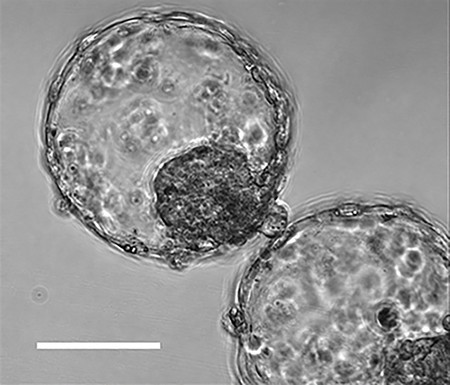
オーストリア:受精卵から胎児の初期細胞を作製:着床を再現(動画):
Austria:Producing early fetal cells from fertilized eggs:
奥地利:从受精卵生产早期胎儿细胞:重新植入
ーiPS細胞で’胚盤胞のような細胞塊’を作製ー
オーストリア
研究グループオーストリアの研究グループが発表しました。
ヒトのiPS細胞などを使って、
受精卵が胎児になる初期段階で、
発現する細胞の塊を作りました。
その細胞塊が、「人工的に作った子宮に似た組織に、着床する様子を再現すること」に成功した。
オーストリア科学アカデミー
分子生物工学研究所
香川晴信研究員
ニコラス・リブロン科学雑誌「ネイチャー」に発表しました。
ヒトiPS細胞とES細胞:
研究グループは、ヒトのiPS細胞とES細胞に、細胞分化を促す物質などを加えて培養。「胚盤胞」を作製:
受精から5日ほどの初期段階で、「胚盤胞」のような細胞の塊を作りました。さらに、
この細胞の塊は「人工的に作ったヒトの子宮の内膜に似せた組織に接着し、着床の最初の様子を再現できた」としています。
生命倫理のガイドライン:
研究グループは、生命倫理のガイドラインに従って、受精から13日目までの段階で培養を終了した。
「不妊の原因解明や治療の研究にもつながる成果だ」としています。
医療 | NHKニュース
https://www3.nhk.or.jp/news/html/20211212/k10013384951000.html
Scientists recreate blastocysts with iPS, ES cells
A group of scientists
have successfully created human blastocyst models from induced pluripotent stem cells and embryonic stem cells.They say
they recreated the early stages of implantation, and the research could lead to further understanding of infertility and its treatment.The research was conducted by a number of researchers including a group
at the Institute of Molecular Biotechnology of the Austrian Academy of Science.
The scientists say
they observed implantation of the cell models called blastoids into a recreated uterine wall that was cultured from human uterine cells.British science magazine Nature carried the article online.
The scientists
cultured iPS cells and embryonic stem cells to create blastoids which are similar to blastocysts of five to seven days after fertilization.The blastoids are similar to natural blastocysts in size and in genetic characteristics of that stage.
The scientists believe their functions are similar.
They stopped culturing after 13 days of fertilization following international ethics guidelines on life science.
Researcher Kagawa Harunobu of the Institute of Molecular Biotechnology of the Austrian Academy of Science
said the results indicate an increase in the success rate of IVF and open up opportunities for people to plan pregnancies more precisely.
NHK WORLD-JAPAN News
https://www3.nhk.or.jp/nhkworld/en/news/20211212_09/
Human blastoids model blastocyst development and implantation
Abstract One week after fertilization, human embryos implant into the uterus.
This event requires that
the embryo forms a blastocyst consisting of a sphere encircling a cavity lodging the embryo proper.Stem cells can form a blastocyst model, which we termed blastoid1.
Here we show that
naive human pluripotent stem cells (PXGL hPSCs)2 triply inhibited for the Hippo, TGF-β, and ERK pathways efficiently (>70%) form blastoids generating blastocyst-stage analogs of the 3 founding lineages (>97% trophectoderm, epiblast, and primitive endoderm)according to the sequence and timing of blastocyst development.
Blastoids spontaneously form the first axis and we observe that
the epiblast induces the maturation of the polar trophectoderm that consequently acquires the specific capacity to attach to hormonally-stimulated endometrial cells, as during implantation.
Such a human blastoid is a faithful, scalable, and ethical model to explore human implantation and development3,4.
Nature